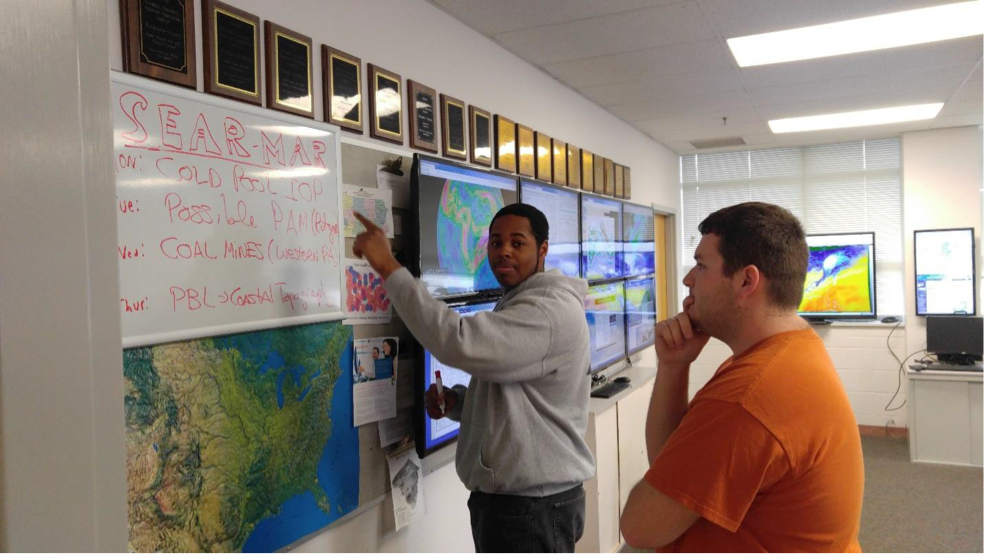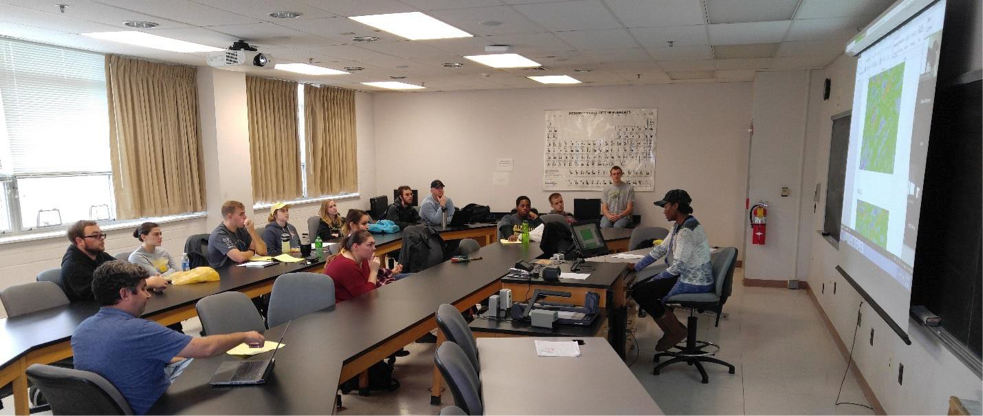Each research flight of the King Air required: i) selection of a scientific mission based on the expected weather conditions, ii) determination of the flight’s takeoff and landing times and flight plan, iii) requests for any required radiosonde support with launch times and locations, and iv) the ability to make changes in this plan as the flight developed. Since the project involved the Wyoming flight crew and universities in four different cities, special methods of communication were needed to accomplish these requirements. Different approaches were used prior to, during, and after a daily noon planning meeting.
The process began with a forecast. Due to time spent on other aspects of the project leading up to the start of operations on 4 NOV (e.g. ground equipment installation), the first meeting with prospective student forecasters did not occur until 31 OCT. It had previously been decided that Millersville University students would develop the forecasts and host the video conference. The call for forecasters was distributed to all Millersville meteorology students with a requirement of one-semester participation in the Campus Weather Service, which would provide students with the practical experience and knowledge of products useful in creating forecasts.
To further leverage the Campus Weather Service, SEAR-MAR students prepared a 5-day forecast each day after the normal 0730 LST weather briefing used to develop a local forecast for Millersville University. With guidance from faculty, the forecasters wrote a summary of the expected weather conditions each day and identified the most favorable scientific mission based on a description of the relevant flight plan and approximate flight times. This was the first document distributed to an e-mail list, which included lead scientists, research associates, the Wyoming crew, and over 100 students at the four institutions. The one-line summaries were also kept on a whiteboard in the Millersville University Weather Information Center (MUWIC) as shown in Figure 5.
On the day before a potential flight, an additional forecast was prepared one hour before the daily planning meeting to confirm the best mission and add additional information from higher resolution models. This was also distributed by e-mail to the same listserv. While the forecasts were intended to be guides to research mission selection, and were occasionally superseded by other participants’ analysis, they ended up having great weight in determining the flight was chosen, so that the students involved in the forecasting were also effectively gaining experience field experiment operations.
The most important communication between partners was the planning meeting, which was held at noon every day of the project until the flight hours were expended. This meeting was used to formally declare the mission and its parameters, including when radiosondes would be launched and from which site. Other announcements of relevance to the project could also be made. While a classroom on the Millersville campus allowed many students from that campus to attend (Fig. 6), any participant could easily join by phone or video conference. The latter made for a more familiar meeting situation and could even be used to provide live weather updates during IOPs. It was also beneficial that the Wyoming crew could join from the airport in close proximity to takeoff and landing times.
For subsequent changes to the mission plan there was first a pre-flight forecast update, which was prepared by that day’s student forecasters and delivered by one of them using video conferencing three hours before the declared takeoff time. This allowed observations and the highest-resolution model runs to be incorporated into the outlook, while also allowing enough time to train those students who were to fly that day. While the start time could not be moved forward after the pre-flight update, it could be pushed back for more favorable conditions or to accommodate slight modifications to the flight plan.
After the flight was airborne, communication was still possible using chat software available on the King Air and to any interested participants on the ground. An important ground station was MUWIC where there was always one or more people following the progress of the mission. If data from early legs was not as expected, mission scientists on the ground could suggest or approve changes to improve the results, such as shifting legs laterally or to a higher altitude. On occasion, chat was also used at Millersville’s ground site if that was involved in the mission, or to communicate with the mobile radiosonde crew.

